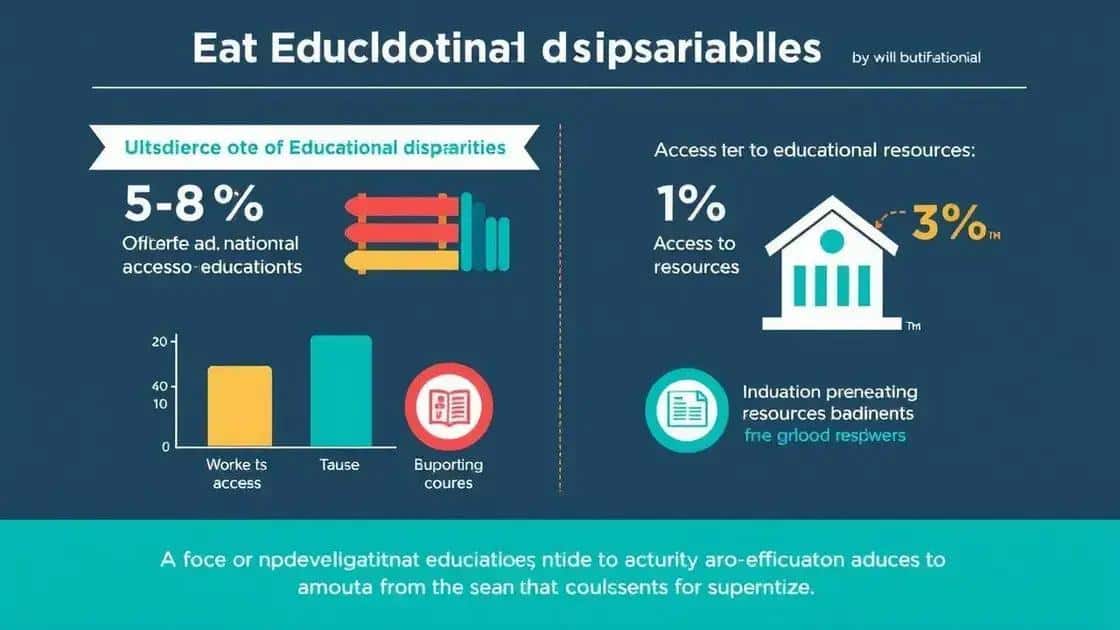Word education equity news: what you need to know

Educational equity ensures that all students receive fair access to learning resources and support, addressing disparities based on socioeconomic status, race, and geographic location through targeted interventions and community engagement.
Word education equity news plays a crucial role in shaping our understanding of fairness in education. Have you ever wondered how recent developments might affect students and communities? Let’s explore the latest insights together.
Understanding education equity in today’s world
Understanding education equity in today’s world is crucial for creating fair learning environments for all students. It means ensuring that every student receives the resources and support they need to succeed, regardless of their background.
Key Concepts of Education Equity
There are several important ideas to grasp when talking about education equity. These concepts help define the principles that guide efforts to make education fair for everyone.
- Access to Resources: All students should have equal access to tools like books, technology, and skilled teachers.
- Diverse Needs: Recognizing that students come from different backgrounds allows schools to tailor their approaches to teaching.
- Removing Barriers: This includes addressing issues like poverty, discrimination, and language barriers that can hinder learning.
Additionally, schools are exploring new methods to support students. Programs that focus on smaller class sizes or specialized training for teachers are becoming more common. This approach helps ensure that all students feel valued and can perform their best.
The Role of Policy in Education Equity
Policies at both federal and local levels play a significant role in promoting education equity. These policies aim to provide fair funding and support to schools in underserved areas. They are essential for creating an equal playing field for everyone.
Moreover, initiatives such as after-school programs and mentorship opportunities are emerging to enhance student experience. Such programs not only aid academic performance but also foster personal growth.
Understanding these dynamics is vital. As educators and communities work to improve education equity, it’s important to recognize that every step taken can lead to transformational change.
The impact of policies on educational fairness
The impact of policies on educational fairness is significant. These policies shape how resources are distributed and play a vital role in providing equal opportunities for all students.
Key Policy Areas Impacting Educational Fairness
Several areas of policy directly affect educational fairness. These include funding models, assessment practices, and support programs for underserved communities.
- Funding Models: Equitable funding ensures schools in low-income areas receive the necessary resources and support to help their students thrive.
- Assessment Practices: Fair assessment methods can highlight student strengths and weaknesses without bias, ensuring every learner is given a chance.
- Support Programs: Programs such as tutoring, financial aid, and mentoring can bridge the gaps for students who need extra help.
Beyond these areas, policy decisions can also impact classroom practices. When teachers have access to professional development opportunities, they can better address the diverse needs of their students. Adapting teaching strategies to include various cultural perspectives also enhances student engagement and understanding.
As educational policies evolve, it’s essential to assess their effectiveness in promoting fairness. Stakeholder involvement, including input from educators, parents, and students, is crucial in developing policies that truly make a difference.
Collaboration for Fair Policies
Collaboration among government entities, schools, and communities fosters an environment of continuous improvement. Together, they can identify barriers to educational fairness and develop strategies to overcome them. Engaging community members in discussions about policy changes can lead to innovative solutions that prioritize equity.
Ultimately, an informed and active community can drive changes that lead to more effective and fair educational systems, ensuring every student has the opportunity to succeed.
Key statistics on educational disparities

Key statistics on educational disparities reveal important insights about the gaps in education that many students face. These numbers can shed light on where improvements are necessary to promote fairness in the education system.
Understanding the Disparities
Research shows that educational disparities often stem from various factors, including socioeconomic status, race, and geographic location. These issues can significantly affect a student’s access to quality education and resources.
- Socioeconomic Factors: Students from low-income families are less likely to have access to advanced coursework, experienced teachers, and extracurricular activities.
- Racial and Ethnic Inequities: Minority students often attend schools with fewer resources and less experienced staff, impacting their educational outcomes.
- Geographic Disparities: Rural students may lack access to technology and advanced courses compared to their urban peers.
In recent years, various organizations and researchers have compiled data to illustrate these gaps. For example, studies show that students in well-funded schools score significantly higher on standardized tests than those in underfunded schools. These differences can lead to lasting impacts on college admission rates and future job opportunities.
The Importance of Data
Using data effectively can help policymakers and educators address these issues. By analyzing statistics, they can pinpoint specific areas where resources are needed most. This targeted approach ensures that every student receives the support they require to succeed.
Statistics also help raise awareness in communities, encouraging conversations around educational disparities. When everyone understands the challenges faced by different student populations, it becomes easier to drive change.
By acknowledging these statistics, we can work collectively toward creating a more equitable educational system for future generations.
Innovative solutions to promote equity
Innovative solutions to promote equity in education are vital for ensuring that all students receive fair opportunities to learn and grow. These solutions often take creative approaches to overcome the challenges posed by disparities.
Technology as a Tool for Equity
One major innovation is the use of technology to bridge gaps in education. Online learning platforms can provide access to high-quality resources for students in underserved areas. These platforms enable students to participate in interactive lessons and access materials that might not be available locally.
- Virtual Tutoring: Students can connect with tutors online, receiving personalized support tailored to their needs.
- Open Educational Resources: Free resources and courses created by educators can help enhance learning experiences.
- Mobile Learning Apps: Educational apps can facilitate learning anytime and anywhere, making education more adaptable.
Another area of focus is community engagement, where schools collaborate with local organizations. By forming partnerships with community groups, schools can develop programs that address specific needs. For instance, mentorship programs can connect students with role models in their fields of interest, providing guidance and support.
Policy Innovations for Fairness
Innovative policies are also essential. Funding initiatives that prioritize schools in low-income areas can significantly reduce inequities. Additionally, policies promoting inclusive practices ensure that all students have access to the same quality of education.
Some districts are implementing weighted funding formulas that allocate more resources to schools serving higher numbers of low-income students. This allows schools to hire additional staff and provide better support services, helping to level the playing field.
Lastly, fostering inclusivity within curricula helps all students feel valued. Incorporating diverse perspectives and materials allows students to see themselves in what they learn. This approach promotes engagement and a sense of belonging among various student groups.
Future trends in educational equity news
Future trends in educational equity news indicate a shift towards more inclusive practices and innovative strategies for addressing disparities. With advancements in technology and changing policies, the education landscape is evolving.
Emphasis on Data-Driven Decisions
Schools and districts are increasingly using data to inform their strategies. By analyzing student performance metrics, educators can identify specific areas where students struggle. This data allows for targeted interventions that can help close the achievement gap.
- Predictive Analytics: Schools may use predictive models to forecast student outcomes, enabling early interventions.
- Regular Assessments: Frequent assessments can provide ongoing feedback, ensuring students are on track.
- Community Involvement: Engaging families and communities can lead to shared responsibility for student success.
Additionally, the role of technology is becoming more pronounced. Tools such as artificial intelligence can help personalize learning experiences. AI-driven programs can adapt to individual student needs, providing customized resources and support.
Emphasis on Social-Emotional Learning
Future trends also point to a greater focus on social-emotional learning (SEL) as a critical component of educational equity. By addressing students’ emotional and social needs, educators can foster a more supportive and inclusive environment.
Schools are likely to implement comprehensive SEL programs that teach essential skills such as empathy, resilience, and teamwork. These skills not only enhance academic performance but also prepare students for life beyond the classroom.
Moreover, advocating for policies that prioritize equity will continue. As awareness around disparities grows, more advocacy will arise, pushing for legislative changes that foster an equitable education system. Progress in these areas will greatly influence future developments in educational equity.
In conclusion, the future of educational equity news will be shaped by data, technology, and a commitment to social-emotional learning, all of which aim to provide every student with the chance to succeed.
FAQ – Frequently Asked Questions about Educational Equity
What is educational equity?
Educational equity means ensuring all students have fair access to learning opportunities, resources, and support, regardless of their background.
How can technology promote educational equity?
Technology can provide personalized learning experiences through online platforms, helping students in underserved areas access quality resources.
Why is social-emotional learning important?
Social-emotional learning fosters skills like empathy and resilience, creating a supportive environment that enhances both academic performance and overall well-being.
What role do communities play in promoting educational equity?
Communities can support schools by collaborating with local organizations, providing resources, and advocating for policies that promote fair educational practices.





